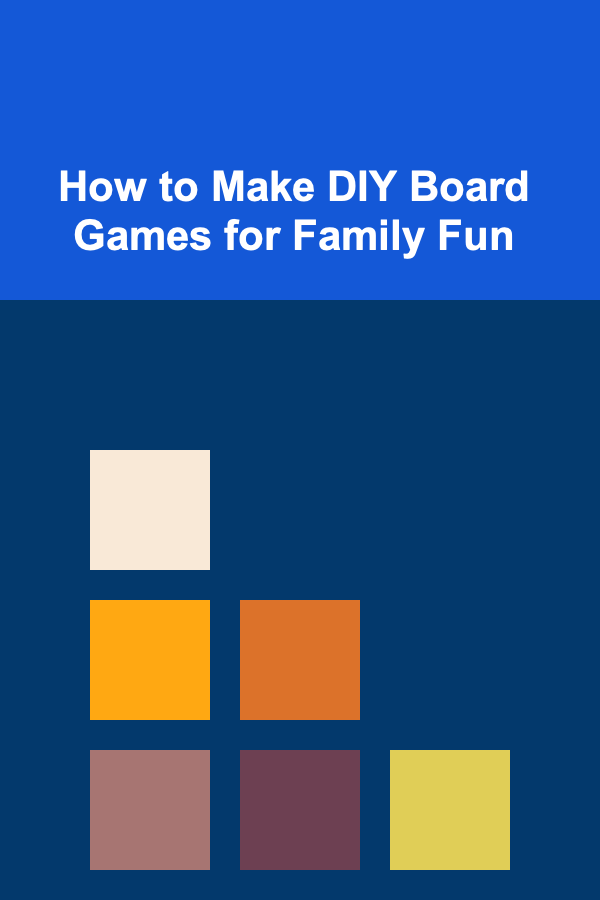
How to Make DIY Board Games for Family Fun
ebook include PDF & Audio bundle (Micro Guide)
$12.99$7.99
Limited Time Offer! Order within the next:

Board games have been a cherished form of entertainment for families for centuries. From Monopoly to Scrabble, these games have provided countless hours of bonding, laughter, and friendly competition. However, there's something uniquely special about creating your own board game. It allows you to customize the rules, design, and theme, making it a personal and creative project. In this article, we'll explore how you can make your own DIY board game for family fun. Whether you're a beginner or have some experience, you can follow this guide to create a board game that will be fun for everyone in the family.
Why Make Your Own Board Game?
Creating a board game isn't just about following a set of rules---it's about having fun with the process and fostering creativity. Here are some reasons why making your own board game can be a rewarding experience:
- Customizable for All Ages: You can create a game that's tailored to the specific interests and age group of your family. Whether you have young children or adults, designing a game that everyone can enjoy is a perfect way to ensure no one feels left out.
- Encourages Creativity: Designing a game from scratch challenges you to think outside the box. You get to create rules, artwork, and themes that reflect your family's unique personality and preferences.
- Strengthens Bonds: Collaborating on a family project, like a DIY board game, fosters teamwork. It encourages discussion, problem-solving, and mutual respect for each other's ideas, all while having fun.
- Personalized Fun: A homemade game often feels more engaging and personal than a store-bought one. The effort and thought put into the game will make it more enjoyable and meaningful for everyone.
In the following sections, we will dive into the process of creating a board game, step by step.
Step 1: Choose a Theme or Concept
The first step in creating a DIY board game is to decide on a theme or concept. The theme will influence the design, rules, and the type of game you create. Choosing a theme will also make the game more engaging and fun for players.
Here are a few ideas to get you started:
- Adventure or Exploration: Create a game where players go on an exciting journey, like exploring ancient ruins or traversing a jungle.
- History or Geography: Use historical events or places as the foundation for the game, such as an exploration of different countries or famous battles.
- Fantasy or Mythology: Base your game on fantastical creatures, magical lands, or heroic quests.
- Everyday Life: A game about family life, household tasks, or even shopping and cooking can be a humorous take on daily activities.
- Puzzle or Mystery: Design a game around solving a mystery, like a detective story or a hidden treasure hunt.
Once you have chosen a theme, think about how the game will unfold. Will players move around a board? Will they face challenges or complete tasks? The theme will help shape your gameplay.
Step 2: Define the Game's Objective and Rules
Every game needs a clear objective and set of rules. The objective is what players are trying to achieve, while the rules govern how they get there. Here are a few tips for defining your game's objective and rules:
2.1. Decide the Winning Condition
What do players need to do to win? This could be something simple, like reaching the finish line first, or more complex, like accumulating points or solving a puzzle. Consider your theme when deciding the win condition---does it align with the story or the goals of the game?
For example:
- In a racing game, the objective might be to get to the finish line before the other players.
- In a mystery-solving game, the objective might be to gather enough clues to solve the case.
- In an adventure game, players might have to collect treasure or complete certain challenges to win.
2.2. Create Simple and Fun Rules
The rules should be easy enough to follow but engaging enough to keep players interested. When creating the rules, think about the following:
- Movement: How will players move around the board? Will they roll dice, draw cards, or move based on strategy?
- Action: What will players do on their turn? Will they draw cards, answer questions, or make decisions?
- Challenges or Tasks: Will there be obstacles or challenges players must overcome? How will they do this? Will they answer trivia, perform tasks, or face random events?
- Player Interaction: How can players interact with each other? Can they trade items, block each other's progress, or cooperate to achieve a common goal?
The rules should also include how players will keep track of their progress, such as using tokens, points, or cards. It's important to keep the rules simple enough so that everyone can understand them but complex enough to maintain excitement.
2.3. Playtest and Refine
Once you've established the rules, it's time to playtest your game. Playtesting helps to see if the rules are easy to understand and if the game is balanced and fun. Invite family members to play the game and pay attention to the following:
- Are the rules clear?
- Is the game too difficult or too easy?
- Is it fun and engaging?
- Are there any parts of the game that feel too slow or repetitive?
Based on feedback from your playtesters, adjust the rules, difficulty level, and flow of the game to make it more enjoyable.
Step 3: Design the Game Board and Components
Now comes the creative part---designing the game board and its components. A visually appealing game board enhances the experience and adds to the theme of the game. You don't need professional-grade design skills for this step---just creativity and some basic materials.
3.1. Creating the Game Board
A typical board game consists of a large board that serves as the playing area. The design of your board will depend on the theme and gameplay. Here are some ideas:
- Path-Based Board: If your game involves moving along a path (like a race), create a winding or straight path on the board with spaces for players to land on.
- Grid-Based Board: A game like chess or checkers uses a grid. You can create a similar setup for your game if it involves strategic movement.
- Modular Board: For an adventure or exploration game, you might want to create a modular board that changes each time you play. This could be done by using tiles that can be rearranged.
The board doesn't need to be large; it can be any size that works for your game. You can use cardboard, foam board, or even a large sheet of paper to draw your design.
3.2. Design Game Pieces
Think about the pieces players will use. These could be anything that represents the player, such as tokens, figurines, or simple items like buttons, coins, or buttons.
If your game involves cards, dice, or spinners, design those elements as well. Cards can be made from index cards or cardstock, and dice can be purchased or made using printable templates or simple cubes.
3.3. Visuals and Artwork
Adding art to the game is a fun way to enhance the theme and make the game feel special. You can create your artwork by hand, print it out, or use digital tools. For instance, you can draw images that represent the theme (e.g., mythical creatures, treasures, landscapes) and place them on the board, cards, or other components.
You can even use online tools to create customized game cards or boards. Websites like Canva offer templates that allow you to design cards, boards, and other game elements with ease.
Step 4: Assemble the Game
Once you have all the components---board, pieces, cards, dice, etc.---it's time to assemble the game. You'll need to:
- Prepare the Board: Cut out the board (if necessary) and place any visual elements on it.
- Create the Pieces: If you're using tokens or figurines, make sure they're ready to go.
- Prepare the Cards: If your game involves cards, print them out or write on them. Consider laminating them to make them more durable.
Organize everything so it's easy to set up and play.
Step 5: Play and Have Fun
Finally, it's time to play! Gather your family, follow the rules, and enjoy the game. As you play, keep in mind that the goal is to have fun, so be open to making modifications if needed.
Conclusion
Creating a DIY board game is an exciting and rewarding project that brings the family together. Not only does it challenge your creativity, but it also provides hours of fun for everyone involved. By following these steps---choosing a theme, defining the rules, designing the components, and playtesting---you can create a game that is not only fun but also a lasting family treasure. The best part? You can continue to refine and expand the game as your family's interests and preferences evolve.
Reading More From Our Other Websites
- [Home Cleaning 101] How to Keep Your Home Clutter-Free While Still Keeping It Clean
- [Home Security 101] How to Upgrade Your Existing Home Security System
- [Personal Care Tips 101] How to Use Nail Polish Remover for a Smooth Manicure Finish
- [Home Soundproofing 101] How to Soundproof Your Home for More Privacy
- [Home Holiday Decoration 101] How to Maximize Small Spaces with Holiday Decor Tips
- [Personal Investment 101] How to Balance Your Portfolio with Schwab PCRA Investments
- [Toy Making Tip 101] TWO HANDS, ONE DREAM: FUN TOY-MAKING ACTIVITIES TO SHARE WITH A FRIEND
- [Home Maintenance 101] How to Keep Your Range Hood in Top Condition
- [Personal Investment 101] Earn Money by Developing and Selling Deep Learning APIs
- [Home Budget Decorating 101] How to Decorate Your Home with Salvaged Items for a Unique Look

Best Organization Tools for Studying and Exams
Read More
How to Build a Checklist for Optimizing Content for SEO
Read More
How to Create a Checklist for Ensuring Customer Onboarding Success
Read More
How to Set the Mood with Lighting for Your Home Party
Read More
How to Discover Series That Have a Strong Fanbase
Read More
How to Make Healthy Fast Food Choices
Read MoreOther Products

Best Organization Tools for Studying and Exams
Read More
How to Build a Checklist for Optimizing Content for SEO
Read More
How to Create a Checklist for Ensuring Customer Onboarding Success
Read More
How to Set the Mood with Lighting for Your Home Party
Read More
How to Discover Series That Have a Strong Fanbase
Read More